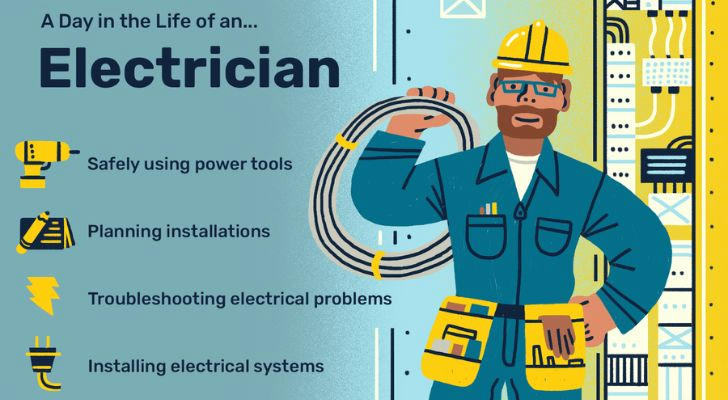How to Start a Career as an Electrician
Electricians play a crucial role in nearly every industry, ensuring that buildings, homes, and infrastructure are powered safely and reliably. With steady demand, hands-on work, and opportunities for long-term growth, a career as an electrician can be both financially rewarding and personally satisfying.
This guide outlines what electricians do, how to get started, the different training paths available, and what to expect in terms of work environment and career advancement.

1. What Does an Electrician Do?
Electricians install, maintain, and repair electrical systems in residential, commercial, and industrial settings. Their responsibilities include:
Reading blueprints and technical diagrams
Installing wiring, outlets, and fixtures
Inspecting and testing electrical systems
Ensuring systems comply with local and national electrical codes
Diagnosing problems and performing repairs
Installing circuit breakers, transformers, and other components
There are also specialized roles within the field, such as residential electricians, commercial electricians, and linemen who work on outdoor power lines.
2. Why Choose a Career as an Electrician?
Starting a career as an electrician offers several advantages:
Strong job outlook: The U.S. Bureau of Labor Statistics projects steady job growth for electricians through 2032.
Competitive pay: Electricians earn above-average wages, especially with experience or specialization.
Hands-on work: Ideal for those who prefer practical tasks over desk-based work.
Low barrier to entry: No four-year degree is required; training is available through apprenticeships and trade schools.
Room for advancement: Opportunities to become a licensed master electrician or start a business.
3. Basic Requirements to Get Started
Before entering an electrician training program, it’s important to meet the general entry criteria:
Age: Typically 18 years or older
Education: High school diploma or GED, with coursework in math and science helpful
Physical condition: Ability to work in confined spaces, climb ladders, and lift equipment
Clean background: Some employers and apprenticeship programs may require a background check
Strong math skills and problem-solving abilities are also useful for this career.

4. Education and Training Paths
There are two main ways to begin training as an electrician: enrolling in a trade school or entering an apprenticeship directly.
Option 1: Trade or Vocational School
Many community colleges and technical schools offer pre-apprenticeship programs in electrical technology. These programs typically last 9 to 12 months and include:
Electrical theory and safety
Blueprint reading
National Electrical Code (NEC) instruction
Basic hands-on skills
Completing a program can make it easier to qualify for apprenticeships or entry-level jobs.
Option 2: Electrical Apprenticeship
An apprenticeship is the most common route to becoming an electrician. It combines paid on-the-job training with classroom instruction, usually over four to five years. Apprenticeship programs are offered through:
Local trade unions (e.g., International Brotherhood of Electrical Workers - IBEW)
Non-union training providers (e.g., Independent Electrical Contractors - IEC)
State labor departments or employer-sponsored programs
Apprentices earn a percentage of a journeyman’s wage and receive annual pay increases as they gain experience.
5. Licensing and Certification
Most states require electricians to be licensed. After completing an apprenticeship or equivalent training, individuals typically must:
Pass a licensing exam covering electrical codes, safety regulations, and theory
Submit proof of training hours
Pay applicable licensing fees
Some electricians choose to pursue certifications in specialized areas, such as solar panel installation or low-voltage systems. Requirements vary by state, so it’s important to check with the local licensing authority.
6. What to Expect on the Job
Work Environment
Electricians work in a variety of settings:
Construction sites (residential and commercial)
Industrial plants and manufacturing facilities
Homes and apartment buildings
Outdoor utility work
The job may involve:
Working in tight or elevated spaces
Exposure to weather conditions (for outdoor work)
Evening, weekend, or on-call hours, depending on the employer
Personal protective equipment (PPE) is essential for safety, including gloves, goggles, and sometimes harnesses.
7. Salary Expectations
Electricians in the U.S. earn a median annual wage of around $60,000 to $65,000, with variation based on location, specialization, and experience.
Entry-level: Around $40,000–$50,000
Experienced journeymen: $60,000–$80,000
Master electricians or contractors: Can earn over $90,000 annually
Urban areas and large-scale industrial employers tend to offer higher wages.

8. Career Advancement Opportunities
Electricians can advance in several ways:
Journeyman to Master Electrician: Master electricians are licensed to oversee large projects and mentor apprentices.
Specialization: Focus on areas such as industrial systems, renewable energy, or HVAC integration.
Self-employment: Many electricians eventually start their own contracting business.
Project management: With experience, some electricians move into supervisory or construction management roles.
Additional certifications and continuing education can also help expand job opportunities.
9. Tips for Getting Started
Take high school courses in math, shop, and physics
Volunteer or intern with a local contractor to gain exposure
Research apprenticeship opportunities early
Prepare for interviews with trade organizations or employers
Stay informed about local licensing requirements
Getting a foot in the door often starts with initiative and a willingness to learn.
Conclusion
A career as an electrician offers stability, skill development, and room for advancement without requiring a college degree. Whether starting through a trade school or jumping straight into an apprenticeship, becoming an electrician is a realistic and rewarding goal for those interested in hands-on work and problem-solving.
With consistent demand across industries and a growing focus on energy efficiency and infrastructure, the electrical field is positioned for long-term relevance and opportunity.
